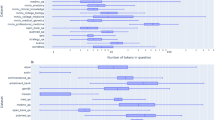
Research in artificial intelligence (AI) is addressing a growing number of tasks through a rapidly growing number of models and methodologies. This makes it difficult to keep track of where novel AI methods are successfully – or still unsuccessfully – applied, how progress is measured, how different advances might synergize with each other, and how future research should be prioritized. To help address these issues, we created the Intelligence Task Ontology and Knowledge Graph (ITO), a comprehensive, richly structured and manually curated resource on artificial intelligence tasks, benchmark results and performance metrics. The current version of ITO contains 685,560 edges, 1,100 classes representing AI processes and 1,995 properties representing performance metrics. The primary goal of ITO is to enable analyses of the global landscape of AI tasks and capabilities. ITO is based on technologies that allow for easy integration and enrichment with external data, automated inference and continuous, collaborative expert curation of underlying ontological models. We make the ITO dataset and a collection of Jupyter notebooks utilizing ITO openly available.
Artificial Intelligence • Benchmark
Sample Characteristic - Location

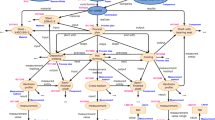
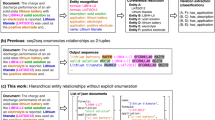
The past decade led to substantial advances in Artificial intelligence (AI). Increases in computational capacity and the development of versatile machine learning models such as deep convolutional neural networks or the transformer architecture made it possible to tackle a wide variety of tasks that were previously deemed intractable 1,2 .
According to the 2021 AI Index Report published by the AI Index Steering Committee of the Human-Centered AI Institute (Stanford University), the number of AI conference publications increased fourfold between the years 2000 and 2019, while the number of AI journal publications grew from roughly 10,000 in the year 2000 to more than 120,000 in the year 2019 3 . Similarly, AI-related publications on the pre-print server arXiv increased more than sixfold within only five years from 2015 to 2020 3 .
This ever-growing amount of research on AI methods, models, datasets and benchmarks makes it difficult to keep track of where novel AI methods are successfully (or still unsuccessfully) applied, how quickly progress happens, and how different AI capabilities interrelate and synergize. This complexity is amplified by the great variety of AI data modalities (e.g., natural language, images, audio, structured data) and application domains (e.g., web search, biology, medicine, robotics, security, advertising). Furthermore, real-world AI systems and the tasks they address are tightly embedded in complex systems of data creation/consumption, non-AI algorithms and social processes. Understanding AI and its global impact requires the creation of rich models that integrate data from these adjacent knowledge domains.
To help address these issues, we introduce the Intelligence Task Ontology and Knowledge Graph (ITO), a comprehensive, richly structured and manually curated data resource on artificial intelligence tasks, benchmark results and performance metrics. ITO is realized as an ontology-backed knowledge graph 4 based on standards minted by the World Wide Web Consortium (W3C). Data are represented through the Resource Description Framework (RDF) 5 and Web Ontology Language (OWL) 6 standards and can be queried through the SPARQL graph query language 7 . These standards have a long history of application in other domains requiring complex knowledge representation and integration, such as biomedical research 8,9,10 .
The following desiderata guided the creation of ITO:
ITO allows for capturing rich relationships between AI processes, models, datasets, input and output data types (e.g., text, video, audio) metrics, performance results and bioinformatics processes. This enables a more in-depth tracking of progress over time, such as analysing how progress trajectories on various classes of tasks compare to each other across different dimensions.
In its current version (v1.01), ITO encompasses more than 50,000 data entities and 9,000 classes.
The primary aim of ITO is to enable ‘meta-research’ concerned with studying scientific research itself in terms of its methods, reporting, evaluation and other aspects to increase the quality of scientific research 11 . The value of ITO for meta-research can be exemplified based on two recent studies utilizing the resource.
As a first step in creating insights from ITO, our group analysed the prevalence of performance metrics currently used to measure progress in AI using data on more than 30,000 performance results across more than 2,000 distinct benchmark datasets. To increase data quality and enable a thorough analysis, we conducted extensive manual curation and annotation of the raw data as part of integrating it into the ontology 12 .
In another recent study, we explored and mapped AI capability gains over time across 16 main research areas (e.g., computer vision, natural language processing, graph processing), further breaking down capability gain by sub-processes described in the curated AI process hierarchy (Barbosa-Silva et al., manuscript in preparation). This analysis made use of both the curated AI process class structure, as well as the cleaned and normalized performance metrics data.
Besides providing a knowledge graph for meta-research, the ontology of ITO can be utilized as a taxonomic resource for annotating and organizing information in the AI domain. For example, in recent work, our group conducted a systematic review of literature and online resources to create a catalogue of AI datasets and benchmarks for medical decision making 13,14 . Identified datasets and benchmarks were manually annotated for meta-information, such as targeted tasks, data types and evaluation metrics. This manual curation process was greatly simplified by using the taxonomic structures provided by ITO together with the OntoMaton ontology annotation widget 15 .
Finally, the ITO knowledge network can serve as a practice-focused resource that allows developers to find, compare and select AI models to address complex use-cases for certain defined tasks, data types and application domains.
Benchmark result and initial task description data was drawn from the ‘Papers with code’ (PWC, https://paperswithcode.com) repository. PWC is the largest repository of AI benchmark data currently available. It is a web-based open platform that contains information on more than 5,000 benchmarks and 50,000 publications. PWC data was collected by combining automatic extraction from arXiv submissions and manual crowd-sourced annotation of benchmark results.
To create the initial version of ITO, PWC data was imported and converted to RDF/OWL with a Python script. After initial data import from PWC, ITO underwent extensive further manual curation. Collaborative manual curation was done using WebProtégé 16 . The top-level class hierarchy of AI processes was derived from the top-level classification of benchmarks on the Papers With Code platform. As an established community of practice, we considered this source to be a good starting point. We were unable to identify other existing resources with a more well-grounded top-level classification of AI tasks. Curation was conducted by two experts in the AI/machine learning domain (KB, MS) over the course of several months. In this process, tasks and benchmarks were systematised and mapped to AI processes. Where appropriate, classes and properties from the following established ontologies were re-used: the EMBRACE Data And Methods (EDAM) ontology 17 , the Open Biomedical Ontologies (OBO) in OWL ontology 18 , the Dublin Core schema 19 and the Friend of a Friend (FOAF) ontology 20 .
The scripts and overall workflow created allow for repeated updating and incremental curation of data over time, so that ITO can be kept up-to-date as benchmark result data in Papers With Code (and potentially other data repositories) keeps evolving. Novel classes and properties identified and imported through our automated scripts were put under the “Meta: Class requiring curation” class or the “Meta: Data property requiring curation” property to flag them for further manual curation by our curators. This way, novel data could be reflected by ITO quickly, while allowing for ongoing manual curation and improvement of the model.
Table 1 provides an overview of the main classes and properties used to capture knowledge in ITO.
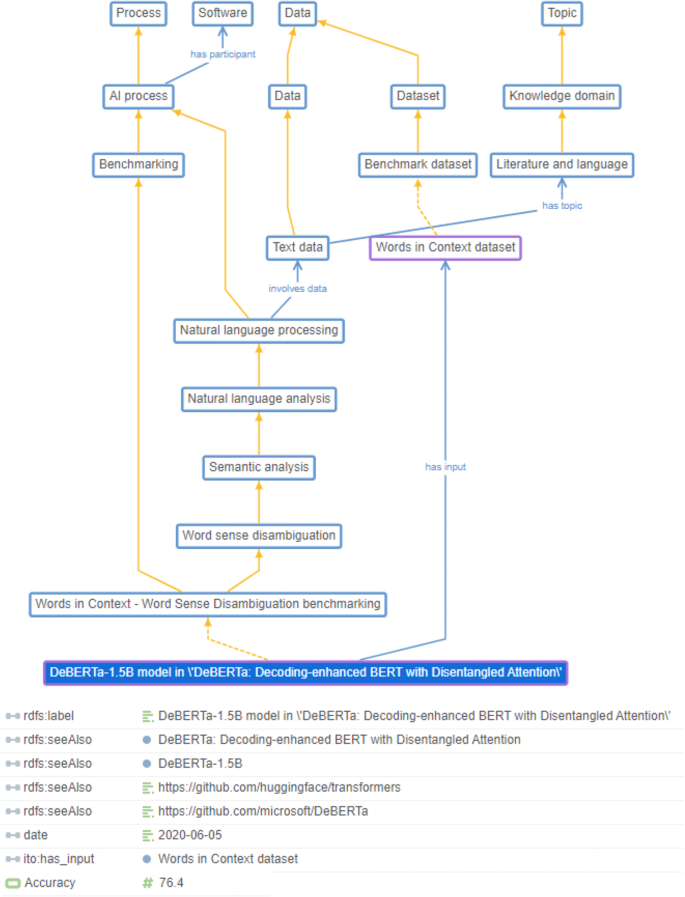
The ITO dataset is made available as a single OWL (Web Ontology Language) file. The ITO model is available as an OWL (Web Ontology Language) file. The latest version of ITO is available on Zenodo (https://doi.org/10.5281/zenodo.5561989) 21 , GitHub (https://github.com/OpenBioLink/ITO) and BioPortal (https://bioportal.bioontology.org/ontologies/ITO). The ontology file is distributed under a CC-BY-SA license.
The current version of ITO (v1.01) encompasses more than 50,000 individuals across more than 9,000 classes. Additional basic metrics are shown in Table 2.
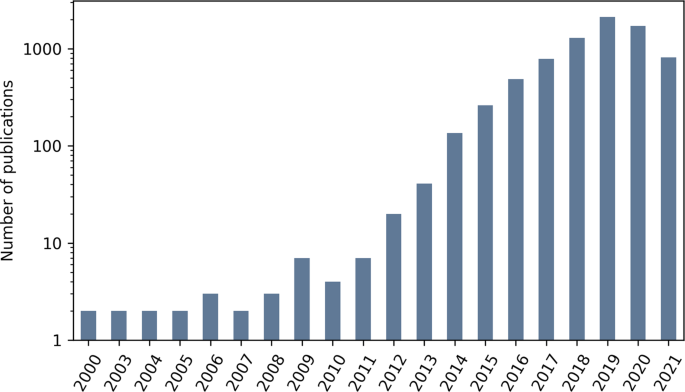
Figure 3 shows the 16 parent process classes, e.g, ‘Natural Language Processing’, ‘Computer vision’ or ‘Audio process’ that are used to map AI processes in ITO together with the number of distinct benchmarks and benchmark results per process. An excerpt of the curated performance measure hierarchy is displayed in Fig. 4.
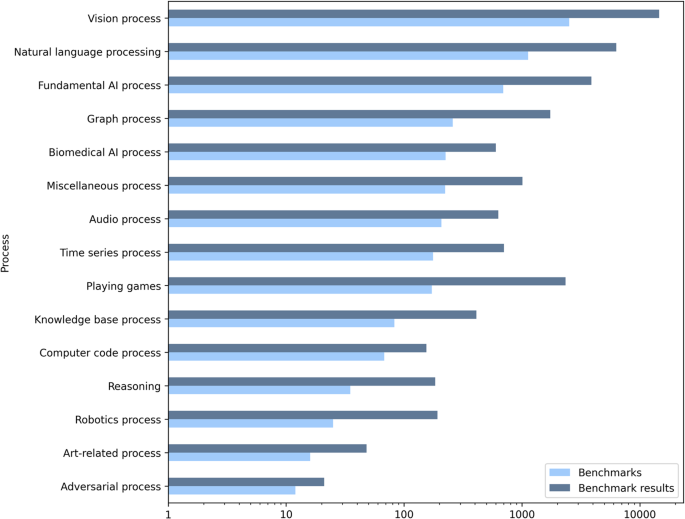
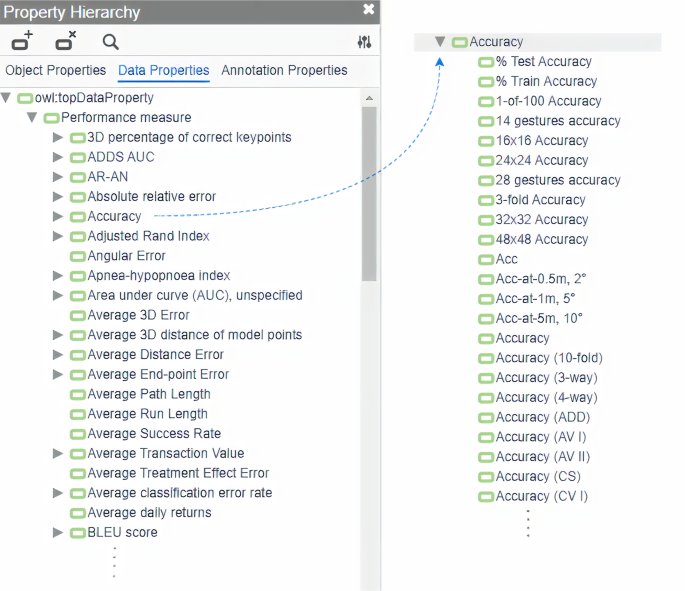
Validation and evaluation of a knowledge graph and/or ontology aims to assess whether the resource adequately and accurately covers the domain it intends to model, and whether it enables an efficient execution of the tasks it was designed for.
Commonly used criteria to evaluate ontologies based on these aspects include accuracy, clarity, completeness, conciseness, adaptability, computational efficiency and consistency 22 .
Accuracy indicates whether the definitions and descriptions of elements in an ontology are correct. Clarity measures whether the ontology’s elements are clearly defined and labeled, and understandable for the user. Achieving high accuracy and clarity was ensured in ITO through an extensive manual curation period lasting several months.
The criterion of completeness is concerned with whether the domain to be modeled is adequately covered by the ontology, while conciseness indicates to which extent the ontology covers only elements relevant to the domain. Both criteria are ensured in ITO through the bottom-up development approach that makes use of existing data (i.e., benchmarks extracted from preprint servers) and concepts relevant to the domain of AI processes instead of a top-down approach that starts with a blank slate. Relying on existing data sources, such as the PWC database that combines automated extraction of benchmarks from papers on preprint servers and crowd-sourced annotation by several thousands of contributors enables high domain coverage. Completeness was further tested by using ITO to annotate a collection of over 450 datasets and AI benchmarks in the biomedical domain, with ITO being found to cover all required concepts to annotate all datasets 13 .
Adaptability is concerned with whether the ontology meets the requirements defined by the range of use cases for which it was built. The practical usability of ITO for its intended applications has been validated within two recently conducted studies (Barbosa-Silva et al., manuscript in preparation) 12 .
Computational efficiency indicates whether the ontology’s anticipated tasks can be fulfilled within reasonable time and performance frames using the available tools. Even complex queries related to the use cases described above can be executed within a few seconds on standard hardware when using the high-performance Blazegraph graph database.
Finally, consistency requires the ontology to be free from any contradictions. Internal consistency was checked using Protégé v5.5.0 and the elk 0.4.3 reasoner 23,24 .
Furthermore, common pitfalls in ontology design and creation have been described, which, for example, include the creation of unconnected ontology elements, missing human readable annotations or cycles in class hierarchies 25,26,27,28 . ITO was checked for these with the ontology quality checking tool ‘OOPS!’ 27 , and identified issues were resolved.
Ontology evaluation metrics were calculated with the Ontometrics tool 29 and were used for ontology quality evaluation following the example of Carriero et al. 30 . Ontology metrics are reported in Table 4.
Table 4 Ontology evaluation metrics.The inheritance number of 1.73 is low, suggesting that ITO is a deep ontology, i.e. the class hierarchy is well grouped and covers the domain in a detailed manner. The relationship richness as calculated by the Ontometrics algorithm of 0.002 is low, which, however is due to the fact that the vast majority of relationships in ITO are captured at the level of OWL individuals rather than classes. The axiom/class ratio is high, indicating a richly axiomatized ontology. The average population number of 5.62 indicates a good balance between the count of individuals (i.e., mostly benchmark results) and the number of classes in the class hierarchy used to structure those results. The class richness of 0.49 suggests that roughly half of the classes in the ontology are not instantiated by individuals; this is due to Data, Data format and Topic branches of the ontology that are primarily used for defining attributes of other classes, rather than being instantiated themselves. The average depth depth value of 5.36 is within the normal ranges for an ontology of the given size. The maximal breadth and absolute sibling cardinality of 4590 and 9037 are very high. This is caused by the modeling decision of creating a process class called Benchmarking, which is the direct superclass of the large number of classes representing benchmarks in the ontology. This design choice also led to a high tangledness metric, i.e. a large number of classes with multiple superclasses, since benchmark classes have both a specific AI task and the Benchmarking class as direct superclasses. While this particular design choice deviates from best practices of ontology design, it proved favorable for ease of querying the ontology, which was an important design goal.
Besides PWC, we also investigated some other projects aiming to track global AI tasks, benchmarks and state-of-the-art results have been initiated in recent years as potential data sources. Among these, the Aicollaboratory 31 and State of the art AI (https://www.stateoftheart.ai/) stood out as the most comprehensive and advanced resources.
‘AIcollaboratory’ is a data-driven framework enabling the exploration of progress in AI. It is based on data from annotated AI papers and open data from, e.g., PWC, AI metrics and OpenML. Similar to the projects described above, benchmark results are organized hierarchically and can be compared per task. In addition, the platform provides summary diagrams that combine all benchmark results per top-level task class, e.g., ‘Natural language processing’ and display progress over time. We found that relevant data in AIcollaboratory were already covered by PWC, and that the project did not seem to be actively maintained at the moment.
‘State of the art AI’ collects AI tasks and datasets, models and papers building on data from PWC, arXiv, DistillPub and others. Similar to PWC, it organises AI tasks, allows for a comparison of results per task, and makes them available on a web-based platform. However, data are not available for download at the time of this writing, and relevant data were already covered by PWC.
There are some ontologies and taxonomies that are related to ITO. The Computer Science Ontology (CSO) 32 is a large-scale ontology created through literature mining that captures research areas and their relations in computer science. WikiCSSH provides a large-scale, hierarchically organized vocabulary of subjects in computer science that was derived from Wikipedia 33 . Compared to ITO, CSO and WikiCSSH have lower coverage of the domain of AI tasks. Outside of the domain of computer science, the Cognitive Atlas Ontology provides concepts of human cognition that partially overlap with concepts from AI 34 .
There are several related projects that aim to capture scientific results through knowledge graphs. The Artificial Intelligence Knowledge Graph (AI-KG) contains a large collection of research statements mined from AI manuscripts 35 . The Open Research Knowledge Graph (ORKG) 36 captures research statements across multiple scientific domains. The Academia/Industry DynAmics (AIDA) Knowledge Graph describes 21 million publications and 8 million patents and utilizes CSO for annotations.
There are also multiple partially related initiatives towards creating large, integrated knowledge graphs in the life sciences. The decentralized nanopublications infrastructure that captures and integrates research statements and their provenance, particularly in the domain of life sciences 37 . More centralized ontology-based knowledge graphs that were recently published include OpenBioLink 38 , Hetionet 39 and PheKnowLator 40 .
To ensure content validity and keeping up with the fast-paced developments in the field of AI, newly available data will be periodically imported. Furthermore, the underlying ontological model will be subject to continuous refinement, and future developments will also focus on creating mappings between ITO and other thematically relevant ontologies and knowledge graphs, particularly AI-KG, ORKG and CSO.
A wide variety of frameworks for OWL, RDF and the SPARQL graph query language can be used to access and query the ontology. Our recommendations for efficient processing include the graph database Blazegraph (https://blazegraph.com) for both simple and complex queries requiring high performance, and the Owlready2 Python library (https://pypi.org/project/Owlready2/) for simple queries and OWL reasoning.
Example Jupyter notebooks for querying the ontology using the libraries mentioned above can be found in the associated Github repository (https://github.com/OpenBioLink/ITO) in the folder ‘notebooks’ (e.g., ‘descriptive_statistics_v1.0’ and ‘trajectories_notebooks’).
To view and edit the ontology, the Protégé ontology editor (https://protege.stanford.edu/) can be used 23 . Furthermore, the class structure of ITO can be browsed online via BioPortal (https://bioportal.bioontology.org/ontologies/ITO).
Code to generate the summary statistics are available from the Github repository in the folder ‘notebooks’: https://github.com/OpenBioLink/ITO. The entire Github repository for the v1.01 release is archived on Zenodo 41 : https://doi.org/10.5281/zenodo.6566103.
The research leading to these results has received funding from netidee under grant agreement 5158 (‘Web of AI’) and the European Community’s Horizon 2020 Programme under grant agreement No. 668353 (‘Ubiquitous Pharmacogenomics’). The authors thank the team of Papers with Code for making their data available. This work was conducted using the Protégé resource, which is supported by grant GM10331601 from the National Institute of General Medical Sciences of the United States National Institutes of Health.